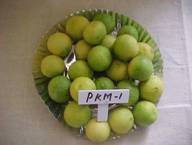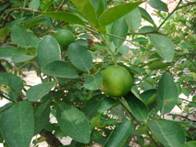Acid Lime (Citrus aurantifolia (Christm) Swingle)
Rutaceae
Varieties
Local varities, PKM1, Vikram and Rasraj are the popular varieties in acid lime.
Soil and climate
The crop can be cultivated in both Tropical and subtropical climate. It can be grown up to 1000 m above MSL. Deep well drained loamy soils are best suited for the cultivation.
Season
The planting is done from December – February and June – September.
Planting
Healthy seedlings are planted during June to December at 5 to 6 m spacing in 75 cm x 75 cm x 75 cm pits.
Irrigation
Irrigate copiously after planting. After establishment of the crop, irrigation is given at 7 – 10 days interval. Water stagnation should be avoided.
Manures and fertilizers per plant
N is applied in two doses during March and October. FYM, P2O5 and K2O are to be applied in October.
Spray Zinc sulphate at the rate of 0.5% (500 g/100 lit of water) thrice in a year (March, July and October) after the emergence of new flushes.
After cultivation
The branches of main stem up to 45 cm from ground level have to be removed. Green leaves @ 30 kg per tree are applied once in 3 months.
Intercropping
Legumes and vegetable crops can be raised during pre-bearing age.
Growth regulator
To increase the fruit set, spray 2, 4 – D @ 20 ppm during flowering stage. For fruit retention, spray 2, 4 – D @ 20 ppm or NAA @ 30 ppm after fruit set (marble size).
Plant protection
Pests Leaf miner The pest can be controlled by spraying Dichlorvos 76 WSC @ 1 ml/lit or Dimethoate 30 EC @ 2 ml/lit or Monocrotophos 36 WSC @ 1.5 ml/lit or neem seed kernel extract (NSKE) @ 50g/lit or 3 % neem cake extract or neem oil.
Leaf caterpillar
When the infestation is moderate to severe, Quinalphos25 EC @ 2ml/lit is sprayed to control to control the pest. The larvae can be hand picked and destroyed.
Sucking pests
Fruit sucking moth
Tinospora weed host have to be destroyed. Bait with fermented molasses plus Malathion 50 EC at the rate of 1 ml/lit can be used for control. Bag the fruits with polythene bags punctured at the bottom. Apply smoke and set up light traps or food lures (pieces of citrus fruits) for control.
Shoot borer
Prune the withered shoots 4 cm below the dried portions and spray Monocrotophos 36 WSC @ 1 ml/lit or Quinalphos25 EC @ 1.5 ml/lit or Carbaryl 50 WP @ 2 g/lit.
Stem borer
The branches containing grubs have to be pruned. Plugging the fresh holes with cotton soaked in Monocrotophos solution mixed @ 5 ml/20 ml of water will also control the pest.
Fruit fly
Mealy bugs
Nematodes
Apply Carbofuran 3 G @ 75 g/tree to control citrus nematodes in severe infestations. Apply 20 g Pseudomonas fluorescens formulation per tree at a depth of 15 cm and 50 cm away from the trunk once in four months. Soil application of Phorate @ 2 g followed by drenching with 1 % of Metalaxyl plus Mancozeb 72 WP @ 50 ml/ cutting/ poly bag/ kg of nursery soil is done for controlling citrus decline.
Diseases
Twig blight Prune dried twigs and spray 3% Copper oxychloride or 0.1% Carbendazim at monthly intervals to reduce the spread of disease.
Scab
Spray 1% Bordeaux mixture to control the disease.
Canker
Immediately after pruning one spray of Copper oxychloride (COC) 0.3% is done followed by 4 sprayings with Streptocyclin100 ppm + COC 1.5 kg/ha at monthly intervals.  Citrus canker
Tristeza virus
Remove the infected trees and destroy. Spray Methyl demeton 25 EC or Monocrotophos @ 1 ml/lit to control the aphids which spread the disease. Use pre-immunized acid lime seedlings for planting.
Harvest
The crop starts bearing from 3rd year after planting.
Post harvest treatment
Treating the fruits with 4% wax emulsion followed by pre-packing in 200 gauge polythene bags with 1 % ventilation improves the shelf life for more than 10 days.
Yield
The crop yields about 25 t/ha/year.
Market information
| |||||||||||||||||||||||||||||||||||||||||||||
Agriculture Information, Agriculture News, Agriculture jobs in India
Monday, 3 March 2014
Horticulture :: Fruit Crops :: Acid lime
Subscribe to:
Post Comments (Atom)


No comments:
Post a Comment